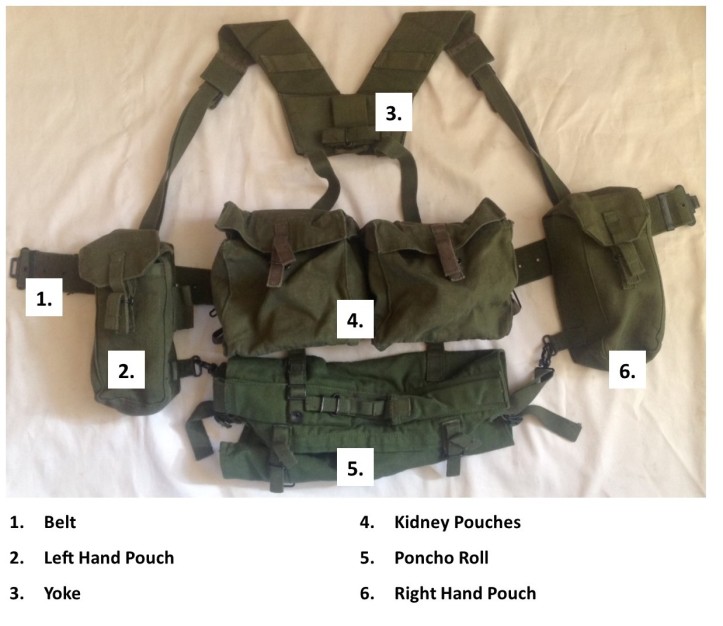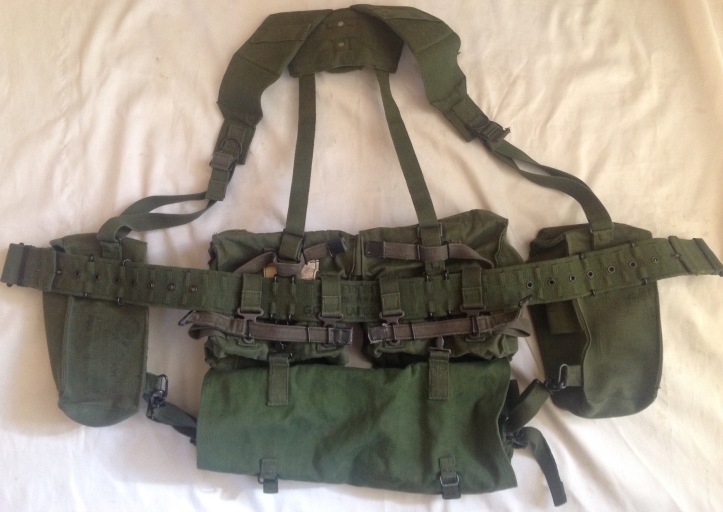The 58 pattern webbing set was the mainstay of the British Army throughout the Cold War and although we have covered odd pieces on the blog before, a recent purchase of a nice clean set of webbing has given the opportunity to go back and look at the set as a whole and then study the missing components not previously covered.
When it was introduced the official list of changes from 1959 described the set as:
The above items of web equipment are hereby introduced to meet the requirements for an improved pattern of equipment for use in temperate and tropical climates. The equipment will enable the soldier in the field to carry his ammunition, rations, water, personal clothing and necessaries. Issue will be restricted to units as nominated by War office from time to time.
The new design comprises two orders, Fighting and Marching.
The main features are:-
- Transference of the weight from the shoulders to the hips
- Transference of the ammunition pouches from the front of the body to the sides of the waist belt.
- The fitting of a yoke to the shoulder straps to provide greater stability
The design was to remain in manufacture for over thirty years and many of the components were updated and their design tweaked with experience. This example is a very late set, but shows the basic principle and the primary components: The water bottle and its carrier were not originally included in the set, and had to be retrospectively added. This component is not shown above, but we have covered it here. Also not illustrated is the large pack, which was universally detested for its poor design, again this has been covered previously here.
The water bottle and its carrier were not originally included in the set, and had to be retrospectively added. This component is not shown above, but we have covered it here. Also not illustrated is the large pack, which was universally detested for its poor design, again this has been covered previously here.
The web gear was attached using a combination of traditional wire ‘c’ hooks and also straps with metal hooks and loops that secured each piece to the belt or yoke: The yoke itself was a major advance for this set of webbing as it was padded and far more comfortable than previous webbing sets and the 58 pattern set was to see service right through until the mid-1990s, with the Falklands campaign being its shining hour. By the fist Gulf War it was partially replaced by PLCE, but was still used by many troops who had not yet received the new PLCE web set.
The yoke itself was a major advance for this set of webbing as it was padded and far more comfortable than previous webbing sets and the 58 pattern set was to see service right through until the mid-1990s, with the Falklands campaign being its shining hour. By the fist Gulf War it was partially replaced by PLCE, but was still used by many troops who had not yet received the new PLCE web set. The first set of fitting instructions gives the following, comprehensive, overview of the set:
The first set of fitting instructions gives the following, comprehensive, overview of the set:
With this equipment a considerable part of the load is normally borne by the waist, but the import of the old adage “a change is as good as a rest” can be brought into effect by the simple expedient of unfastening the buckle of the belt, thus transferring the load entirely to the shoulders. The equipment can be assembled in “fighting order” or in “marching order” and by means of easily adjustable straps the load can be shifted whilst the wearer is on the move. The front of the body is kept free from encumbrances which might restrict certain movements.
The items of this equipment, which are not interchangeable with similar items of earlier types of webbing equipment, have been designed to accommodate the latest types of arms and accessories issued to the Services, including the lightweight pick and shovel.
Description of the Equipment
The main items of equipment are made of rotproofed and water repellent lightweight webbing, dyed to British Standard Camouflage Colour no 15.
The metal fittings are principally of light alloy with a dull protective finish which should not be removed. Quick release fittings have been used wherever possible to give quick access to the contents of the pouches etc.
The following are the component parts, which can be assembled in a variety of combinations to meet differing load carrying requirements:
- Belt, Waist
- Carrier, Cape
- Pack
- Pouch, Amunition, Left
- Pouch, Ammunition, Right
- Pouches, Rear (pair forming one item)
- Straps, Utility (two)
- Yoke